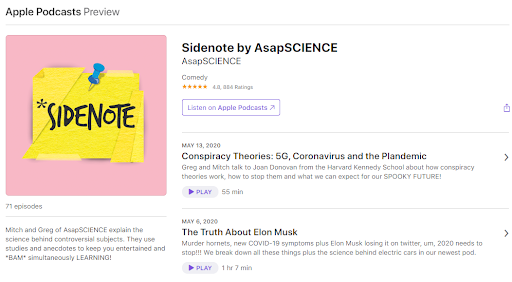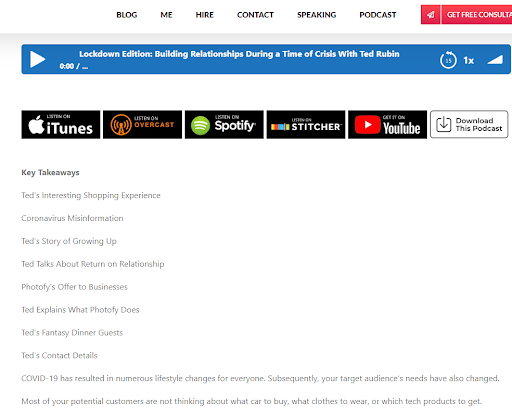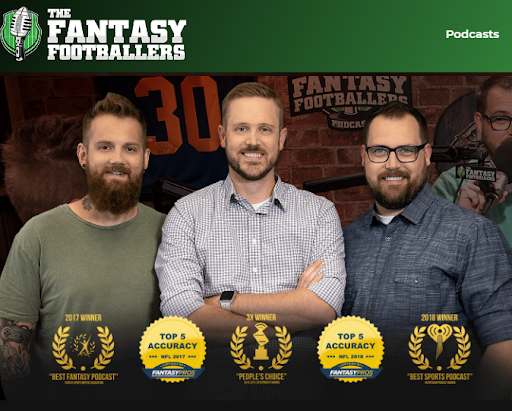30-second summary:
- Google advanced search helps you get granular with your searches and deliver hyper-focused searches with the help of search operators (or a combination of them).
- For example, you can search for articles published in the last week by your competitors or discover internal linking opportunities you might’ve missed.
- In this how-to guide, Venngage’s Aditya Sheth outlines six Google advanced search hacks you need to know to master Google search and become a better SEO.
I have to come clean on something: I’m lazy.
While being lazy may not be a virtue, it does come with an unseen advantage: It allows you to look for creative ways to get things done without necessarily spending more time.
And as an SEO, I’m always looking for ways to get more done without working longer hours. Essentially: aiming to accomplish more with less.
One way to do more with less is to look for tools, tactics or even hacks that help you cut down time wasted and get more done, faster.
One of my favorite hacks ever? Google advanced search.
But what is it? In simple terms, the Google advanced search helps you fine-tune your searches to find exactly what you’re looking for.
This is an especially useful skill if you want to quickly pull up small-bits of information without always having to rely on tools like Ahrefs, Moz, or SEMRush to do it for you.
In this how-to SEO guide, you’ll use advanced search operators to:
- Find duplicate content that could be hurting your site’s rankings.
- Uncover a gold mine of guest posting opportunities in your niche.
- Discover missed internal linking opportunities.
Before we dive into the meat of this guide, first things first:
A mini-crash course on advanced search operators
To keep things simple, we’re going to cover four operators I, as an SEO, use most often.
The first operator is the site search operator. What this allows you to do is retrieve results from a single website. All you have to do is type site:[any website] into Google.
For example, If I enter site:semrush.com, I will only see results pertaining to SEMrush:

You don’t need the http://, https://, or www prefixes when using the site operator.
That’s not all, you can even use a keyword in addition to the site operator to find if that site has written any content around that keyword.
Let’s say I want to find whether we’ve covered the keyword “infographic” on the site. I’ll enter “site:semrush.com infographic” and this is what comes up:
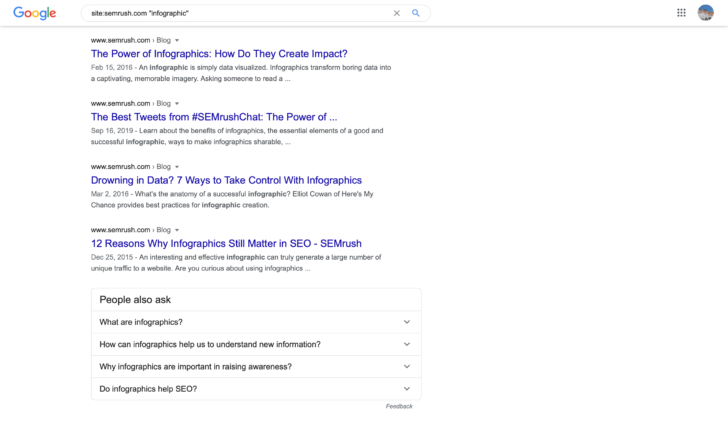
I personally use the site operator very frequently as it limits my search results to a single domain. Keep this operator in mind as we’re going to be relying on it later.
The next operator you’ll find useful is the quotes or exact-match (“”) operator. What the exact-match operator does is limit your searches to exact-match phrases only.
For example, here is a normal Google search (notice the number of results):

And now the same phrase wrapped in quotation marks:
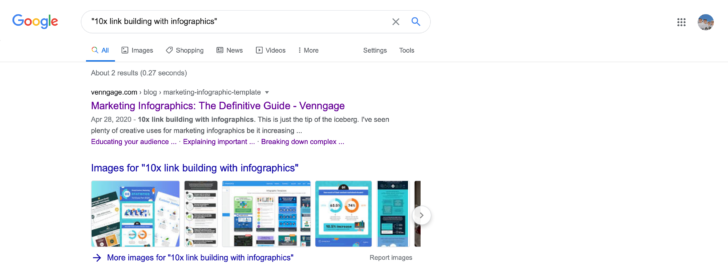
Notice something different?
Compared to a normal Google search, exact-match queries will only show you results where your keyphrase has been mentioned exactly as it is (and not a variation).
This operator is especially powerful to identify if your site has any duplicate content that could be sabotaging your rankings (more on this later).
Last but not the least, we’re going to learn the dash (-) and plus (+) operators to perform laser-targeted searches.
What the dash (-) operator does is excludes certain keywords from appearing in the search results. So if I wanted to read about the topic of search engines but not search engine optimization, I’d use the following query:
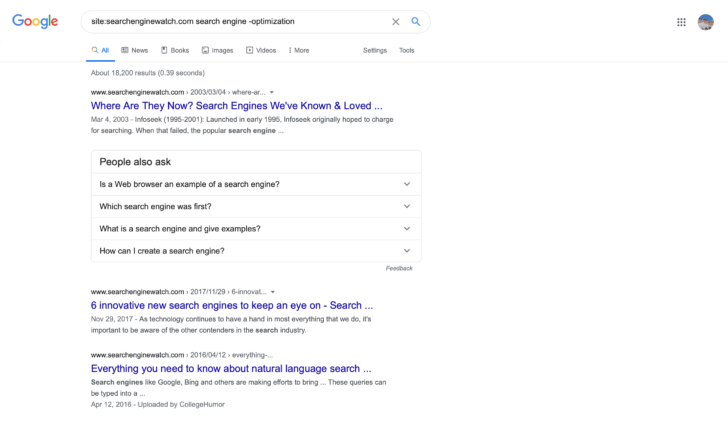
By using the “- optimization” in my search, I’ll only see results about search engines and not search engine optimization.
The plus (+) operator, you guessed it — does the exact opposite. You can use the plus operator to add words to your original search and show you a different set of results.
For example, here’s a query I entered in Google search:

What did I do here? I used the site:, dash and plus operators in conjunction to show me articles that closely relate to search engine marketing but not SEO on the Search Engine Watch blog.
Venngage
There are many search operators out there (too many to list in fact). You can find a much more comprehensive list of search operators on the Moz blog.
But for simplicity’s sake, we’re going to stick to the site, exact match, dash, and plus operators in this guide.
Six Google advanced search tips for better SEO
Using the Google advanced search operators above, you can access exactly what you’re looking for and spend less time searching for it.
Advanced search can come really handy especially when you’re just starting out and don’t have the budget for expensive SEO tools.
Imagine all the endless possibilities that lie in wait for you as an SEO; if only you got better at googling. Well, it’s easier than you think. I’ll show it to you:
1. Conduct basic but insightful competitor research
Conducting competitor research on Google is really easy. All you have to do is use the “related:” search operator followed by a website URL.
“Related:” allows you to find sites that are closely related to a specific URL. You can use related to identify not only direct competitors but also indirect peripheral competitors that you might’ve missed in your competitor research.
Not only that, the related: operator also helps you understand how Google is categorizing your competitors and your website.
Let’s look at what Google returns if we search for competitors related to Venngage
I already know the first three results are our direct competitors, but the last two are surprising because they seem to be indirectly competing with us (and I wasn’t even aware of them).
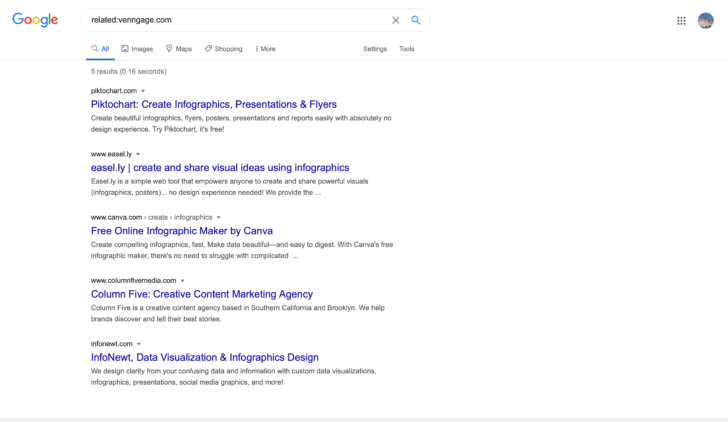
We’re an online infographic maker tool while both Column Five Media and InfoNewt appear to be done-for-you agencies. Google has identified and categorized them as sites related to Venngage which is an insightful find.
Don’t dismiss this advanced search hack because of its simplicity. Try it for yourself and see what Google comes up with. You might just come away with a better understanding of the competition as it pertains to SEO.
2. Stalk your competitor’s content strategy
Sticking to the topic of competitor research, here’s a cool way you can spy on your competitor’s content strategy: combining the site operator and Google’s date-range filter.
Let’s try this on one of our direct competitors: Piktochart.

To limit my search to only blog-related results, I’ll use Piktochart’s/blog subdomain instead of their website. And by the looks of it, they have 790 pages on their blog.
I can use the date-range filter (click on tools and filter by date) to further drill down these results to identify what content they published in the last month only. Here’s what comes up:
This not only tells me Pitkchart published four new articles last month but also gives me insight into Piktocharts’ content strategy and the keywords they’re targeting.
You can find even more data by filtering the results by days, months, or custom time periods.
I can even include exact-match (“your keyword” in quotes) keywords to find out how much content Piktochart has published on any given topic, which is a clever way to uncover their topic cluster strategy.
Let’s take content marketing as a topic for example
Using the site operator in conjunction with the date filters on Google search gives you information on:
- How much content your competition has published till date
- How often they publish new content in a given time period
- What kind of content they publish at a certain point in time
- How often your competitor has written about a given topic
Pretty cool right?
3. Unearth a gold mine of guest posting opportunities
If your goal is to drive quality traffic back to your website, pick up high-quality backlinks, boost your website’s domain authority and even rank higher on Google — guest blogging will help you do all of the above.
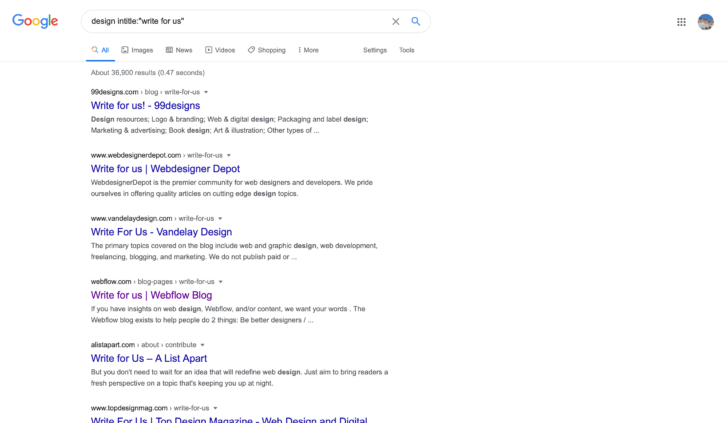
Anybody that tells you guest blogging is dead is either lying or in on it. Guest blogging still works, even in 2020.
Now that we’ve briefly covered how important guest blogging really is, how do you uncover guest blogging opportunities in your niche or industry?
Here are a few advanced search queries you can copy and paste into Google
- Your Keyword “guest post opportunities”
- Your Keyword “guest post”
- Your Keyword “submit guest post”
- Your Keyword “submit blog post”
- Your Keyword intitle:“write for us”
- Your Keyword intitle:“guest post guidelines”
If I’m looking to guest post for sites in the design space, for example, I’d use the following query:
Sites bookmarked. Guest post pitches sent. Fingers crossed.
Try out these search queries for yourself and you’ll be able to build a respectable list of sites to contribute for.
Brian Dean has the most exhaustive guide on guest blogging I’ve read (it includes a huge list of search operators that will help you find even more guest posting opportunities).
4. Discover hidden opportunities for internal linking
Internal linking plays a small but important role in the ranking factors that determine how well you rank on Google.
Irrespective of how well-designed and easy-to-navigate your site may be, a great internal linking structure can make all the difference when it comes to driving traffic from one post to another across your entire blog.
Internal linking also creates topical relevance by creating supporting content for the main topics of your website.
A few weeks ago, I published a mammoth webinar guide on the Venngage blog. I wanted it to start driving traffic to the post and rank for high-volume keywords immediately.
I got to work by finding out where I could link to our guide internally from as many relevant posts on our blog as possible. All I did was use the site operator and the keyword “webinar”: 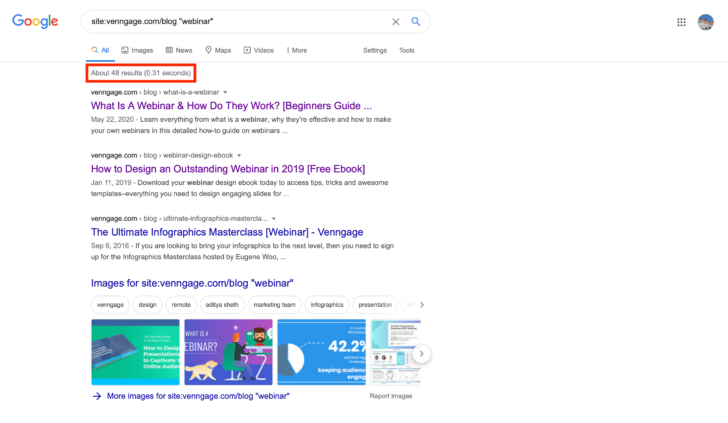
Boom! Barring the first result, I found 47 internal linking opportunities with a simple search. And all it took was a few seconds.
You can even use this search query: site:www.yourwebsite.com/blog intext:”your keyword” to pretty much do the same thing.
This advanced search hack won’t be as useful if you’ve recently started blogging, but it will come in handy if you manage a huge blog that already has a lot of existing content.
5. Find duplicate content on your website
Duplicate content is content that appears on more than one location on your website and can confuse search engines when it comes to deciding which page to rank higher.
In short: Duplicate content can hurt your website rankings and it’s a technical SEO issue you cannot afford to ignore.
To show you an example of duplicate content, I’ll use this small piece of copy from the Apple Airpods product description on Walmart:

Using the site operator, I’ll paste the copy into Google using the exact-match operator. Here’s what I come up with:

The same piece of copy shows up on six other pages on Walmart. Things could be a lot worse but still, not ideal.
But if I were to search for the same piece of copy across the web (not just Walmart) using the dash operator, this is what comes up:

The same piece of copy appears on ~19,000 other websites (excluding Walmart). That’s a lot of duplicate content.
Duplicate content is especially a major issue for website blogs with 1,000s of pages or ecommerce sites with the same product descriptions.
6. Find missed content opportunities
One of the last search operators I’ll cover is the “filetype” operator.
Filetype can help you find non-HTML content on your site, such as Word Documents or PDF files. This content is often valuable, but not search optimized. And traffic to it doesn’t show up in your Analytics.
To use this search operator, simple type in “site:yourwebsite.com filetype:pdf” like so:

Then look at that content. Have you published it as HTML content? Is it search optimized? Is there an opportunity to make it a valuable, rank-worthy and trackable webpage?
PDF files are often the rust of the internet, added to sites because the content manager doesn’t have an easy way to publish actual web pages.
They should always be an alternate (print-friendly, download-friendly) version of HTML content. They should almost never be the only version of a piece of content.
Your turn to master Google search
Congratulations! You’ve officially made it to the end of this mammoth guide.
Google is far more powerful and robust than we realize or give it credit for.
Knowing what to search for and how to search for it with the help of Google advanced search operators will help you harness Google’s true power and in turn, grow your site.
As SEOs, our job comprises running SEO tests, tinkering with Google’s algorithms, and staying on top of the latest search trends.
Google advanced search is not only a fun skill that you can learn over the weekend. It can help you uncover opportunities hiding in plain sight and help you be more effective at your job.
The real kicker
Google is and always will be free. The know-how to fine-tune your searches will help you become a better SEO and pay dividends over the long term.
Has using Google advanced search in your day-to-day made you a better SEO? Which search operators do you use most frequently? Did I miss any advanced search tips? Drop them in the comments below.
Aditya Sheth does Content & SEO at Venngage. You can connect with him on Linkedin or find him on Twitter @iamadityashth.
The post Google advanced search: Six powerful tips for better SEO appeared first on Search Engine Watch.
from SEO – Search Engine Watch https://ift.tt/2Bf50xC
via IFTTT
